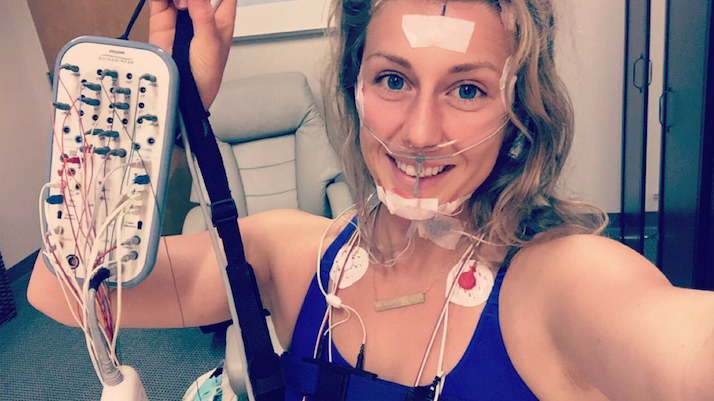The following article by Sara Isenberg was originally published in Santa Cruz Tech Beat

(Photo above: The author is all wired up for the polysomnography, widely recognized by the medical community as the gold standard for measuring sleep objectively. Fullpower performs nightly clinical-grade sleep studies of volunteers to refine Sleeptracker® accuracy. Sign up at https://www.fullpower.com/studies/sleep. Contributed.)
Paid to run on West Cliff? It’s all part of the job.
For the past two summers, I have interned at Fullpower in Santa Cruz. Compared to classmates who are interning at Amazon, Stryker, Medtronic, or Hulu, it seems my experience has been pretty unique, even in tech. For example, how many people get paid to run on West Cliff in Santa Cruz while checking for bugs and measuring accuracy of a new Nike+ Run app?
Last year, I applied to several biomedical startups in the valley. The resulting interviews entailed hours of sweating in traffic in my “Interview Outfit,” driving over the hill during the heat wave of my Spring Break. While in Mountain View, I got to poke pig hearts while learning about a new catheter ablation technique to treat atrial fibrillation. The next day at another interview, I tried on the stealthiest hearing aid soon to be on the market, then ate chipotle with the CEO while he gave me life advice based on decades of starting and selling companies in the biotech space. One thing he said stuck with me — to work in Biomedical Engineering I had to live in Boston, Minnesota, or the Valley. But that night in Santa Cruz, I heard of Fullpower from a friend at Crossfit West. After several casual phone interviews, I found out I got the job! On my first day at Fullpower, I arrived in the dreaded “Interview Outfit” only to see everyone wearing Nikes and running shorts. I was ecstatic with the dress code and knew I would fit in well.
During my first summer at Fullpower (2015), their Sleeptracker® Technology Platform was in early development. This meant as interns we recorded tons of data to compare design iterations and algorithm versions. At times, we made changes to the prototype or made recommendations based on patterns we saw in the data. On other days, we moved around the $4,000 mattresses. The MotionX Activity Tracking Technology Platform (used by Jawbone, Nike+ Run Club, Movado Swiss smartwatches, and others) also needed data collection and accuracy comparisons. This meant almost daily runs along West Cliff carrying multiple phones to measure the distance, steps, and speed accuracy (among other run metrics) reported by different code engine versions and phone models. Working on both of these products, I learned about the process that converts meaningless sensor data into accurate conclusions about running speed and step count or heart rate and sleep cycle.
Continue reading this article in Santa Cruz Tech Beat